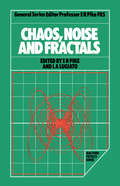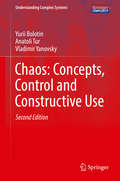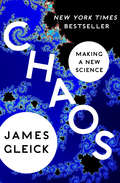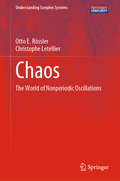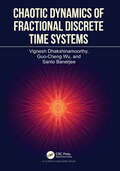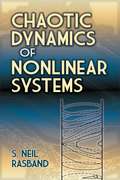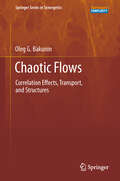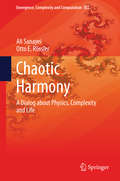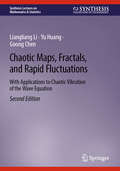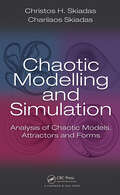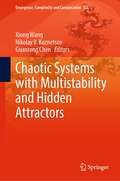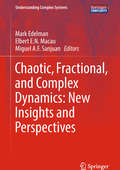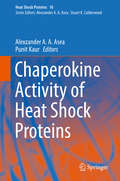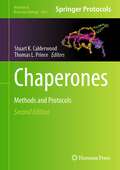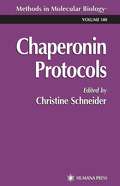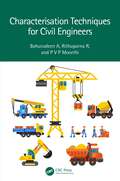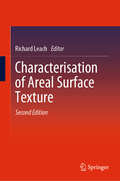- Table View
- List View
Chaos, Noise and Fractals
by E R Pike; L A LugiatoThe study of nonlinear dynamical systems has been gathering momentum since the late 1950s. It now constitutes one of the major research areas of modern theoretical physics. The twin themes of fractals and chaos, which are linked by attracting sets in chaotic systems that are fractal in structure, are currently generating a great deal of excitement. The degree of structure robustness in the presence of stochastic and quantum noise is thus a topic of interest. Chaos, Noise and Fractals discusses the role of fractals in quantum mechanics, the influence of phase noise in chaos and driven optical systems, and the arithmetic of chaos. The book represents a balanced overview of the field and is a worthy addition to the reading lists of researchers and students interested in any of the varied, and sometimes bizarre, aspects of this intriguing subject.
Chaos, Synchronization and Structures in Dynamics of Systems with Cylindrical Phase Space (Understanding Complex Systems)
by Nikolai Verichev Stanislav Verichev Vladimir ErofeevThis book develops analytical methods for studying the dynamical chaos, synchronization, and dynamics of structures in various models of coupled rotators. Rotators and their systems are defined in a cylindrical phase space, and, unlike oscillators, which are defined in Rn, they have a wider “range” of motion: There are vibrational and rotational types for cyclic variables, as well as their combinations (rotational-vibrational) if the number of cyclic variables is more than one. The specificity of rotator phase space poses serious challenges in terms of selecting methods for studying the dynamics of related systems. The book chiefly focuses on developing a modified form of the method of averaging, which can be used to study the dynamics of rotators. In general, the book uses the “language” of the qualitative theory of differential equations, point mappings, and the theory of bifurcations, which helps authors to obtain new results on dynamical chaos in systems with few degrees of freedom. In addition, a special section is devoted to the study and classification of dynamic structures that can occur in systems with a large number of interconnected objects, i.e. in lattices of rotators and/or oscillators. Given its scope and format, the book can be used both in lectures and courses on nonlinear dynamics, and in specialized courses on the development and operation of relevant systems that can be represented by a large number of various practical systems: interconnected grids of various mechanical systems, various types of networks including not only mechanical but also biological systems, etc.
Chaos, Turbulenzen und kosmische Selbstorganisationsprozesse
by Ulrich Von KusserowDieses Buch bietet eine anschauliche und reich bebilderte Übersicht zur Vielfalt kosmischer Turbulenz- und Selbstorganisationsszenarien und ermöglicht umfassende Einblicke in die dabei in ganz unterschiedlichen Zusammenhängen ablaufenden Vorgänge und zugrundeliegenden theoretischen Konzepte. Es richtet sich an fachwissenschaftlich interessierte Laien, Studenten und Wissenschaftler, die einen Einstieg in diese Themenbereiche suchen. Der Autor zeigt auf, nach welchen Gesetzen Selbstorganisationsprozesse überall im Kosmos insbesondere auch die Entstehung der Galaxien, Sterne und Planeten sowie die Entwicklung des Lebens auf dem Planeten Erde möglich gemacht haben. In ansprechender Weise schlägt er einen weiten Bogen über eine Vielzahl chaotischer Vorgänge und Turbulenzen, geordneter Strukturbildungs- und Entwicklungsprozesse in der Natur, die uns Menschen aus dem Alltagsleben teilweise sehr wohl bekannt sind. Die näheren Erläuterungen mathematisch-physikalischer Modellierungsansätze und wissenschaftlicher Forschungsmethoden ermöglichen dem Leser ein wesentlich grundlegenderes Verständnis der dabei Einfluss nehmenden physikalischen, chemischen und biologischen Prozesse.
Chaos, dynamics, and fractals
by Joseph L. MccauleyThis book develops deterministic chaos and fractals from the standpoint of iterated maps, but the emphasis makes it very different from all other books in the field. It provides the reader with an introduction to more recent developments, such as weak universality, multifractals, and shadowing, as well as to older subjects like universal critical exponents, devil's staircases and the Farey tree. The author uses a fully discrete method, a â theoretical computer arithmetic', because finite (but not fixed) precision cannot be avoided in computation or experiment. This leads to a more general formulation in terms of symbolic dynamics and to the idea of weak universality. The connection is made with Turing's ideas of computable numbers and it is explained why the continuum approach leads to predictions that are not necessarily realized in computation or in nature, whereas the discrete approach yields all possible histograms that can be observed or computed.
Chaos: A Very Short Introduction
by Leonard A. SmithChaos exists in systems all around us. Even the simplest system can be subject to chaos, denying us accurate predictions of its behavior, and sometimes giving rise to astonishing structures of large-scale order. Here, Leonard Smith shows that we all have an intuitive understanding of chaotic systems. He uses accessible math and physics to explain Chaos Theory, and points to numerous examples in philosophy and literature that illuminate the problems. This book provides a complete understanding of chaotic dynamics, using examples from mathematics, physics, philosophy, and the real world, with an explanation of why chaos is important and how it differs from the idea of randomness. The author's real life applications include the weather forecast, a pendulum, a coin toss, mass transit, politics, and the role of chaos in gambling and the stock market. Chaos represents a prime opportunity for mathematical lay people to finally get a clear understanding of this fascinating concept.
Chaos: Concepts, Control And Constructive Use (Understanding Complex Systems)
by Yurii Bolotin Anatoli Tur Vladimir YanovskyThis book offers a short and concise introduction to the many facets of chaos theory. While the study of chaotic behavior in nonlinear, dynamical systems is a well-established research field with ramifications in all areas of science, there is a lot to be learnt about how chaos can be controlled and, under appropriate conditions, can actually be constructive in the sense of becoming a control parameter for the system under investigation, stochastic resonance being a prime example. The present work stresses the latter aspects and, after recalling the paradigm changes introduced by the concept of chaos, leads the reader skillfully through the basics of chaos control by detailing the relevant algorithms for both Hamiltonian and dissipative systems, among others. The main part of the book is then devoted to the issue of synchronization in chaotic systems, an introduction to stochastic resonance, and a survey of ratchet models. In this second, revised and enlarged edition, two more chapters explore the many interfaces of quantum physics and dynamical systems, examining in turn statistical properties of energy spectra, quantum ratchets, and dynamical tunneling, among others. This text is particularly suitable for non-specialist scientists, engineers, and applied mathematical scientists from related areas, wishing to enter the field quickly and efficiently. From the reviews of the first edition: This book is an excellent introduction to the key concepts and control of chaos in (random) dynamical systems [. . . ] The authors find an outstanding balance between main physical ideas and mathematical terminology to reach their audience in an impressive and lucid manner. This book is ideal for anybody who would like to grasp quickly the main issues related to chaos in discrete and continuous time. Henri Schurz, Zentralblatt MATH, Vol. 1178, 2010.
Chaos: Making a New Science
by James GleickThe &“highly entertaining&” New York Times bestseller, which explains chaos theory and the butterfly effect, from the author of The Information (Chicago Tribune). For centuries, scientific thought was focused on bringing order to the natural world. But even as relativity and quantum mechanics undermined that rigid certainty in the first half of the twentieth century, the scientific community clung to the idea that any system, no matter how complex, could be reduced to a simple pattern. In the 1960s, a small group of radical thinkers began to take that notion apart, placing new importance on the tiny experimental irregularities that scientists had long learned to ignore. Miniscule differences in data, they said, would eventually produce massive ones—and complex systems like the weather, economics, and human behavior suddenly became clearer and more beautiful than they had ever been before.In this seminal work of scientific writing, James Gleick lays out a cutting edge field of science with enough grace and precision that any reader will be able to grasp the science behind the beautiful complexity of the world around us. With more than a million copies sold, Chaos is &“a groundbreaking book about what seems to be the future of physics&” by a writer who has been a finalist for both the Pulitzer Prize and the National Book Award, the author of Time Travel: A History and Genius: The Life and Science of Richard Feynman (Publishers Weekly).
Chaos: The World of Nonperiodic Oscillations (Understanding Complex Systems #Vol. 84)
by Otto E. Rössler Christophe LetellierWritten in the 1980s by one of the fathers of chaos theory, Otto E. Rössler, the manuscript presented in this volume eventually never got published. Almost 40 years later, it remains astonishingly at the forefront of knowledge about chaos theory and many of the examples discussed have never been published elsewhere. The manuscript has now been edited by Christophe Letellier - involved in chaos theory for almost three decades himself, as well as being active in the history of sciences - with a minimum of changes to the original text.Finally released for the benefit of specialists and non-specialists alike, this book is equally interesting from the historical and the scientific points of view: an unconventionally modern approach to chaos theory, it can be read as a classic introduction and short monograph as well as a collection of original insights into advanced topics from this field.
Chaotic Dynamics
by Geoffrey R. GoodsonThis undergraduate textbook is a rigorous mathematical introduction to dynamical systems and an accessible guide for students transitioning from calculus to advanced mathematics. It has many student-friendly features, such as graded exercises that range from straightforward to more difficult with hints, and includes concrete applications of real analysis and metric space theory to dynamical problems. Proofs are complete and carefully explained, and there is opportunity to practice manipulating algebraic expressions in an applied context of dynamical problems. After presenting a foundation in one-dimensional dynamical systems, the text introduces students to advanced subjects in the latter chapters, such as topological and symbolic dynamics. It includes two-dimensional dynamics, Sharkovsky's theorem, and the theory of substitutions, and takes special care in covering Newton's method. Mathematica code is available online, so that students can see implementation of many of the dynamical aspects of the text.
Chaotic Dynamics in Planetary Systems (Springer Praxis Books)
by Sylvio Ferraz-MelloThe main theme of the book is the presentation of techniques used to identify chaotic behavior in the evolution of conservative mechanical systems and their application to astronomical systems. It results from graduate courses given by the author over the years both at university and at several international summer schools.Along the book surfaces of section, Lyapunov characteristic exponents, frequency maps, MEGNO, dense grid maps, etc., are presented and discussed in connection with the applications. The initial chapter is devoted to the presentation of the main ideas of the chaotic dynamics of conservative systems in plain language so that they can be accessible to a wide range of professionals and students of physical sciences. The applications are mainly related to the motions in the solar system and extrasolar planetary systems.Another chapter is devoted to the applications to asteroids showing how the asteroidal belt is sculpted by chaos and resonances. The contrasting existence of gaps in the distribution of the asteroids and groups of asteroids in resonances is thoroughly discussed. The interest in applications to planetary systems is growing since the discovery of systems of resonant planets around some stars of the solar neighborhood. Exoplanets added a lot of cases to a problem that was before restricted to the planets of our solar system. The book includes an account of results already existing about compact systems.
Chaotic Dynamics of Fractional Discrete Time Systems
by Santo Banerjee Vignesh Dhakshinamoorthy Guo-Cheng WuThe book reviews the application of discrete fractional operators in diverse fields such as biological and chemical reactions, as well as chaotic systems, demonstrating their applications in physics. The dynamical analysis is carried out using equilibrium points of the system for studying their stability properties and the chaotic behaviors are illustrated with the help of bifurcation diagrams and Lyapunov exponents.The book is divided into three parts. Part I deals with the application of discrete fractional operators in chemical reaction-based systems with biological significance. Two different chemical reaction models are analysed- one being disproportionation of glucose, which plays an important role in human physiology and the other is the Lengyel – Epstein chemical model. Chaotic behavior of the systems is studied and the synchronization of the system is performed. Part II covers the analysis of biological systems like tumor immune system and neuronal models by introducing memristor based flux control. The memductance functions are considered as quadratic, periodic, and exponential functions. The final part of the book reviews the complex form of the Rabinovich-Fabrikant system which describes physical systems with strong nonlinearity exhibiting unusual behavior.
Chaotic Dynamics of Nonlinear Systems (Dover Books on Physics)
by S. Neil RasbandWritten when the young science of chaos was gaining a foothold in the scientific community, this book introduces the field's concepts, applications, theory, and technique. Suitable for advanced undergraduates and graduate students, researchers, and teachers of mathematics, physics, and engineering, the text's major prerequisite is familiarity with differential equations and linear vector spaces. Author S. Neil Rasband discusses the major models for the transitions to chaos exhibited by dynamic systems, introducing the "classical" topics and examples fundamental to the discipline. The most important routes to chaos are presented within a unified framework and supported by integrated problem sets. Topics include one- and two-dimensional maps, universality theory, fractal dimension, differential and conservative dynamics, and other subjects. The text is supplemented by a helpful glossary, references, and an index.
Chaotic Flows: Correlation Effects, Transport, and Structures (Springer Series in Synergetics #10)
by Oleg G. BakuninThe book introduces readers to and summarizes the current ideas and theories about the basic mechanisms for transport in chaotic flows. Typically no single paradigmatic approach exists as this topic is relevant for fields as diverse as plasma physics, geophysical flows and various branches of engineering. Accordingly, the dispersion of matter in chaotic or turbulent flows is analyzed from different perspectives. Partly based on lecture courses given by the author, this book addresses both graduate students and researchers in search of a high-level but approachable and broad introduction to the topic.
Chaotic Harmony: A Dialog about Physics, Complexity and Life (Emergence, Complexity and Computation #11)
by Ali Sanayei Otto E. RösslerThis fascinating book written by Ali Sanayei and Otto E. Rössler is not a classic scientific publication, but a vivid dialogue on science, philosophy and the interdisciplinary intersections of science and technology with biographic elements. Chaotic Harmony: A Dialog about Physics, Complexity and Life represents a discussion between Otto Rössler and his colleague and student, focusing on the different areas of science and highlights their mutual relations. The book's concept of interdisciplinary dialogue is unusual nowadays although it has a long tradition in science. It provides insight not only into interesting topics that are often closely linked, but also into the mind of a prominent scientist in the field of physics, chaos and complexity in general. It allows a deep look into the fascinating process of scientific development and discovery and provides a very interesting background of known and unknown facts in the areas of complex processes in physics, cosmology, biology, brains and systems in general. This book will be valuable to all who are interested in science, its evolution and in an unconventional and original look at various issues. Surely it can serve as an inspiration for students, explaining the often overlooked fact that science and philosophy enrich each other.
Chaotic Maps, Fractals, and Rapid Fluctuations: With Applications to Chaotic Vibration of the Wave Equation (Synthesis Lectures on Mathematics & Statistics)
by Yu Huang Goong Chen Liangliang LiThis book was developed from lecture notes for an introductory graduate course and provides an essential introduction to chaotic maps in finite-dimensional spaces. Furthermore, the authors show how to apply this theory to infinite-dimensional systems corresponding to partial differential equations to study chaotic vibration of the wave equation subject to various types of nonlinear boundary conditions. The book provides background on chaos as a highly interesting nonlinear phenomenon and explains why it is one of the most important scientific findings of the past three decades. In addition, the book covers key topics including one-dimensional dynamical systems, bifurcations, general topological, symbolic dynamical systems, and fractals. The authors also show a class of infinite-dimensional nonlinear dynamical systems, which are reducible to interval maps, plus rapid fluctuations of chaotic maps. This second edition includes updated and expanded chapters as well as additional problems.
Chaotic Modelling and Simulation: Analysis of Chaotic Models, Attractors and Forms
by Christos H. Skiadas Charilaos SkiadasOffers Both Standard and Novel Approaches for the Modeling of SystemsExamines the Interesting Behavior of Particular Classes of ModelsChaotic Modelling and Simulation: Analysis of Chaotic Models, Attractors and Forms presents the main models developed by pioneers of chaos theory, along with new extensions and variations of these models. Using more
Chaotic Systems with Multistability and Hidden Attractors (Emergence, Complexity and Computation #40)
by Guanrong Chen Xiong Wang Nikolay V. KuznetsovThis book presents a collection of new articles written by world-leading experts and active researchers to present their recent finding and progress in the new area of chaotic systems and dynamics, regarding emerging subjects of unconventional chaotic systems and their complex dynamics.It guide readers directly to the research front of the new scientific studies. This book is unique of its kind in the current literature, presenting broad scientific research topics including multistability and hidden attractors in unconventional chaotic systems, such as chaotic systems without equilibria, with only stable equilibria, with a curve or a surface of equilibria. The book describes many novel phenomena observed from chaotic systems, such as non-Shilnikov type chaos, coexistence of different types of attractors, and spontaneous symmetry breaking in chaotic systems. The book presents state-of-the-art scientific research progress in the field with both theoretical advances and potential applications. This book is suitable for all researchers and professionals in the areas of nonlinear dynamics and complex systems, including research professionals, physicists, applied mathematicians, computer scientists and, in particular, graduate students in related fields.
Chaotic, Fractional, and Complex Dynamics: New Insights and Perspectives (Understanding Complex Systems)
by Miguel A. F. Sanjuan Mark Edelman Elbert E. N. MacauThe book presents nonlinear, chaotic and fractional dynamics, complex systems and networks, together with cutting-edge research on related topics. The fifteen chapters - written by leading scientists working in the areas of nonlinear, chaotic, and fractional dynamics, as well as complex systems and networks - offer an extensive overview of cutting-edge research on a range of topics, including fundamental and applied research. These include but are not limited to, aspects of synchronization in complex dynamical systems, universality features in systems with specific fractional dynamics, and chaotic scattering. As such, the book provides an excellent and timely snapshot of the current state of research, blending the insights and experiences of many prominent researchers.
Chaperokine Activity of Heat Shock Proteins (Heat Shock Proteins #16)
by Alexzander A. Asea Punit KaurChaperokine, is a term that describes the unique function of extracellular heat shock protein (eHsp) as both chaperone and cytokine. The cellular consequence of binding and signaling of eHsp is the stimulation of a potent and long lasting immune response. eHsp induces a plethora of immune responses including the release of bioactive mediators like cytokines, chemokines, nitric oxide, apotogenic mediator, stimulation of the innate and adaptive immune response, migration and maturation of dendritic cells (DC) and the enhancement of natural killer cell-mediated cellular cytotoxicity.The book Chaperokine Activity of Heat Shock Proteins provides the most comprehensive review on contemporary knowledge on the chaperokine activity of heat shock proteins (HSP) in biology and medicine. Using an integrative approach to understanding the chaperokine activity of HSP, the contributors provide a synopsis of novel mechanisms, signal transduction pathways and how the principles of the chaperokine activity of HSP has been harnessed for therapeutic gain. To enhance the ease of reading and comprehension this book has been subdivided into various section, including; Section I, reviews current progress on our understanding of Immunological and Inflammatory Responses; Section II, evaluates the role of Physiological Responses and Section III, focuses the reader on the Therapeutic Approach. Key basic and clinical research laboratories from major universities, academic medical hospitals, biotechnology and pharmaceutical laboratories around the world have contributed chapters that review present research activity and importantly project the field into the future. The book is a must read for researchers, postdoctoral fellows and graduate students in the fields of Translational Medicine, Clinical Psychologists, Human Physiology, Zoologists, Botanists, Biotechnology, Molecular Medicine, Infectious Diseases Experts, Pathologists, Pharmaceutical Scientists and Researchers involved in Drug Discovery.
Chaperones: Methods and Protocols (Methods in Molecular Biology #1709)
by Stuart K. Calderwood Thomas L. PrinceThe proteome consists of a complex mixture of proteins each of which need to be folded correctly in order to function for the health of the organism, and many of these proteins require molecular chaperones to reach the correct conformation and, in some cases, to remain in a folded form. In Molecular Chaperones: Methods and Protocols, expert researchers address a wide variety of approaches to the study these mechanisms, featuring the workings of heat shock proteins and heat shock transcription factors, in vitro and in vivo. Written in the highly successful Methods in Molecular Biology(tm) series format, chapters features introductions to their respective topics, lists of the necessary materials and reagents, step-by-step, readily reproducible laboratory protocols, and tips on troubleshooting and avoiding known pitfalls. Authoritative and cutting-edge, Molecular Chaperones: Methods and Protocols serves as an ideal guide for all scientists who wish to pursue this vital biological action and its impact on human health and disease.
Chaperones: Methods and Protocols (Methods in Molecular Biology #2693)
by Stuart K. Calderwood Thomas L. PrinceThis second edition volume expands on the previous edition with new discussions on the latest techniques used to study molecular chaperones and the stress response. The chapters in this book cover such as analysis of the initiation and regulation of the stress response; the role of heat shock protein 90 (Hsp90) in gene expression through chromosome-immunoprecipitation; features of chaperone function and biology; the emerging role of the extracellular HSPs; and the use of chaperones as biomarkers. Written in the highly successful Methods in Molecular Biology series format, chapters include introductions to their respective topics, lists of the necessary materials and reagents, step-by-step, readily reproducible laboratory protocols, and tips on troubleshooting and avoiding known pitfalls.Cutting-edge and thorough, Chaperones: Methods and Protocols, Second Edition is a valuable resource for all researchers who want to learn more about this interesting and developing field.
Chaperonin Protocols (Methods in Molecular Biology #140)
by Christine SchneiderChristine Schneider has assembled a unique collection of readily reproducible protocols for the study of chaperonins, intracellular proteins critical to many biological processes. Written by experienced investigators who have successfully honed their methods to a fineness, the protocols focus on the purification of chaperonins from different species along with their corresponding cofactors, and on chaperonin activity assays for in vivo as well as in vitro work. Many activity assays are given for GroEL, which can also be applied to mitochondrial Hsp60. There are also assays for the eukaryotic chaperonin TRiC and handy methods-for example, one for preparing labeled probes-that can be used for various purposes and prove helpful in numerous different procedures. Informative and highly practical, Chaperonin Protocols offers both novice and experienced investigators fast access to today's best and most productive chaperonin methods, all explained in step-by-step detail to ensure robust and reproducible results.
Characterisation Techniques for Civil Engineers
by Bahurudeen A Rithuparna R P V MoorthiThe primary aim of this book is to provide an understanding of the sophisticated, modern characterisation techniques in the domain of civil engineering. It systematically covers physical, chemical, mineralogical and microstructural characterisation, which is imperative to evaluate the construction materials and their performance. It describes tools such as rheometers, thermogravimetric analysers, scanning electron microscopes, X-ray diffractometers and other miscellaneous methods. In each chapter, a detailed scientific background, instrumentation details, working principles, and applications of a specific technique are provided. Features: • Describes rheological and microstructural characterisation testing. • Discusses sophisticated characterisation techniques for construction materials. • Explains the detailed procedure of sample preparation and testing. • Provides detailed descriptions of different parts of the instruments and their purposes. • Includes questions and answers at the end of each chapter. This book is aimed at graduate students and researchers in civil engineering.
Characterisation of Areal Surface Texture
by Richard LeachThe function of a component part can be profoundly affected by its surface topography. There are many examples in nature of surfaces that have a well-controlled topography to affect their function. Examples include the hydrophobic effect of the lotus leaf, the reduction of fluid drag due to the riblet structure of shark skin, the directional adhesion of the gecko foot and the angular sensitivity of the multi-faceted fly eye. Surface structuring is also being used extensively in modern manufacturing. In this way many properties can be altered, for example optical, tribological, biological and fluidic. Previously, single line (profile) measurements were adequate to control manufacture of surfaces, but as the need to control the functionality of surfaces increases, there is a growing need for three-dimensional (areal) measurement and characterisation techniques. For this reason there has been considerable research, development and standardisation of areal techniques. This book will present the areal framework that is being adopted by the international community. Whereas previous books have concentrated on the measurement aspects, this book concentrates on the characterisation techniques, i.e. how to interpret the measurement data to give the appropriate (functional) information for a given task. The first part of the book presents the characterisation methods and the second part case studies that highlight the use of areal methods in a broad range of subject areas - from automobile manufacture to archaeology. Contents Introduction to Surface Topography The Areal Field Parameters The Areal Feature Parameters Areal Filtering Methods Areal Form Removal Areal Fractal Methods Choosing the Appropriate Parameter Characterisation of Individual Areal Features Multi-Scale Signature of Surface Topography Correlation of Areal Surface Texture Parameters to Solar Cell EfficiencyCharacterisation of Cylinder Liner Honing Textures for Production Control Characterisation of the Mechanical Bond Strength for Copper on Glass Plating Applications Inspection of Laser Structured Cams and Conrods Road Surfaces
Characterisation of Areal Surface Texture
by Richard LeachThis second edition delves into surface topography, exploring its impact on the functionality of various components. Beginning with an introduction to surface topography in Chapter 1, the subsequent chapters delve into the areal field parameters, feature parameters, filtering methods, and form removal techniques, leading into more specialized topics such as fractal-related multiscale geometric characterization and deep learning-based quantification of surface texture. With a focus on characterizing measurement data to glean functional insights, the book presents a comprehensive framework adopted by the international community. Through a diverse array of case studies spanning automotive applications, road surface engineering, additive manufacturing, and precision machining, readers are offered a holistic understanding of how areal techniques are pivotal in modern manufacturing industries. This edition builds upon the foundation laid by its predecessor, integrating evolving standards and additional case studies to provide an updated and comprehensive resource for modern surface engineering.
